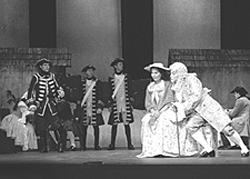

Packing a full house Wednesday evening, Jules Massenet's Manon opened this week in Hall Auditorium. While the story itself is not the most engaging, the slow plot was forgiven due to stellar performances, extravagant costumes and an overall solid production.
Manon, like so many operas, is a simple enough story: a very beautiful, but very middle-class young French girl is about to be denied her entire adolescence as she is on her way to begin her service with the local convent. However, when she finds herself in the right place - a local tavern in Amiens - at the right time - just as the dashing young Chevalier Des Grieux enters the picture, the real story begins to unfold.

Like Carmen, Norma and other late 19th century heroine operas, Manon ends in tragic death and sorrow. However, unlike Bizet and Bellini, Massenet is less forgiving in his casting. The opera passes minimal character development to its title lead; we see the young Manon metamorphose from an irresistible 16-year-old girl to an aristocratic society woman in the course of three hours, revealing little character development in between. In short, Manon is a slow-paced walk through a looking-glass view of 19th century French aristocracy. Thankfully, Oberlin is fortunate enough to employ a flawless cast, clad in absolutely gorgeous period attire, with the backdrop of a polished production to hold our hand through an otherwise average opera.
Double-cast as Manon, seniors Rhiannon Giddens and Erika Tolano fill important shoes, though not in the traditional sense of playing the lead. Their obligation is not so much in their ability to sing incredibly difficult arias or recitatives but to convince their audience of their character's three-act transformation. From the first instant that Manon appears on stage, she must engage her audience immediately. And she does, especially against the contrast of the surrounding cast, frozen in place. Giddens, who appears in tonight's performance, couldn't be more convincing or as childlike in her mannerisms, though unlike Tolano, her height works against her casting. But Giddens' innocent smiles and shy glances in awe of the carefree lifestyles of the local women she encounters - convincingly delivered by seniors Ariadne Votava, Marcia Davis and junior Laurie Rubin - shed light on Manon's own social position. We sympathize with her; we are drawn to her; we believe her. We want her to enjoy an exciting life as much as we believe she deserves it. And we're happy for her when she falls in love a mere ten minutes into her performance.
Following a colorful, comical opening scene, Manon, who has met up with her cousin Lescaut outside the aforementioned local tavern, awaits her convent-bound coach when she encounters two men. The first, Guillot Morfontaine, is a rather insignificant flirt, but hysterically well-acted by sophomore Scott Mello. The second is Manon's unwitting soulmate, the Chevalier Des Grieux, played by seniors James Morera and Jan Kvistborg, opposite Giddens and Tolano, respectively. Though we follow the Chevalier through times of elation and drama, there are no particularly striking solos, but his performance is solid throughout. Instead, the spotlight is focused sharply on Manon, and yet she too is denied very many opportunities to really shine, which is a shame.
Performing as a couple, however, Manon and the Chevalier are stunning. Their first duet, "Nous vivrons á Paris," is well delivered, and in it we are given the first glimpse of the chemistry that will only escalate throughout the rest of the performance. We follow the characters through their short-lived stay in the Chevalier's Paris apartment, their break-up, and Manon's unavoidable relationship with Lescaut's companion, De Brétigny. Unfortunately, junior Jon Stinson's portrayal is shadowed by his character's bad rap. However, in a brilliantly-scored quartet in the second scene with Manon, the Chevalier and Lescaut, the composer's skill shines, if but for a moment.
After an unnecessarily slow scene at Sainte Sulpice, where the Chevalier is about to take his own vows with the church, he and Manon are reunited in an impassioned duet, and the opera's second half has begun. And yet, the opera's story lags. It is almost disappointing that even with sets as beautiful as the Hotel Transylvania in Act Three, there is still very little action to keep audience members from yawning. We can look forward to trios from the three actresses - Votava, Davis and Rubin - but there is little other substance in Massenet's score to keep opera-goers thoroughly entertained. On the flip side, the quality of the orchestra is the one redeeming musical element of Massenet's Manon. Conductor Robert Spano, whose list of lifetime achievements in the program notes runs miles beyond Massenet's own, couldn't have done a finer job. The music of Manon sounds sharp and polished, but is not so upfront that it overpowers the singers.
Though the particularly trivial story falls backdrop to the performances, the scenery, and thousand-dollar ball gowns, make up for the slack. Aren't powdered wigs and huge embroidered dresses what going to the opera is all about? If nothing else, Manon as a spectacle is worth watching and listening to, so long as you have patience to sit through the slower parts. Besides, opera is ultimately about its divas, and with this performance, Manon's divas deliver.
Jules Massenet's Manon runs tonight and Saturday night at 8 p.m., and Sunday at 2 p.m. Tickets are $8 with OCID and are available through Central Ticket Service.
Manon takes Oberlin: Massenet's classic is set to wow Hall audiences this weekend. (photo by Becky Tuch)
Copyright © 1999, The Oberlin Review.
Volume 128, Number 10, November 19, 1999
Contact us with your comments and suggestions.